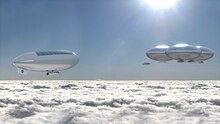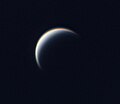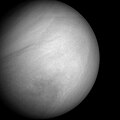Colonization of Venus

The colonization of Venus has been a subject of many works of science fiction since before the dawn of spaceflight, and is still discussed from both a fictional and a scientific standpoint. However, with the discovery of Venus's extremely hostile surface environment, attention has largely shifted towards the colonization of the Moon and Mars instead, with proposals for Venus focused on habitats floating in the upper-middle atmosphere[1] and on terraforming.
Background
[edit]Space colonization is a step beyond space exploration, and implies the permanent or long-term presence of humans in an environment outside Earth. Colonization of space was claimed by Stephen Hawking to be the best way to ensure the survival of humans as a species.[2] Other reasons for colonizing space include economic interests, long-term scientific research best carried out by humans as opposed to robotic probes, and sheer curiosity. Venus is the second largest terrestrial planet and Earth's closest neighbor, which makes it a potential target.
Advantages
[edit]
Venus has certain similarities to Earth which, if not for the hostile conditions, might make colonization easier in many respects in comparison with other possible destinations. These similarities, and its proximity, have led Venus to be called Earth's "sister planet".
At present it has not been established whether the gravity of Mars, 0.38 times that of the Earth, would be sufficient to avoid bone decalcification and loss of muscle tone experienced by astronauts living in a micro-gravity environment. In contrast, Venus is close in size and mass to the Earth, resulting in a similar surface gravity (0.904 g) that would likely be sufficient to prevent the health problems associated with weightlessness. Most other space exploration and colonization plans face concerns about the damaging effect of long-term exposure to fractional g or zero gravity on the human musculoskeletal system.
Venus's relative proximity makes transportation and communications easier than for most other locations in the Solar System. With current propulsion systems, launch windows to Venus occur every 584 days,[3] compared to the 780 days for Mars.[4] Flight time is also somewhat shorter; the Venus Express probe that arrived at Venus in April 2006 spent slightly over five months en route, compared to nearly six months for Mars Express. This is because at closest approach, Venus is 40 million km (25 million mi) from Earth (approximated by perihelion of Earth minus aphelion of Venus) compared to 55 million km (34 million mi) for Mars (approximated by perihelion of Mars minus aphelion of Earth) making Venus the closest planet to Earth.
Venus's atmosphere consists mostly of carbon dioxide. Because nitrogen and oxygen are lighter than carbon dioxide, breathable-air-filled balloons will float at a height of about 50 km (31 mi). At this height, the temperature is a manageable 75 °C (348 K; 167 °F). At 5 km (3.1 mi) higher, it is a temperate 27 °C (300 K; 81 °F) (see Atmosphere of Venus § Troposphere).
Additionally, the upper atmosphere could provide protection from harmful solar radiation comparable to the protection provided by Earth's atmosphere. The atmosphere of Mars, as well as the Moon provide little such protection.[5][6][7]
Difficulties
[edit]
Venus also presents several significant challenges to human colonization. Surface conditions on Venus are difficult to deal with: the temperature averages around 464 °C (737 K; 867 °F),[8] higher than the melting point of lead, which is 327 °C (600 K; 621 °F)C. The atmospheric pressure on the surface is also at least ninety times greater than on Earth, which is equivalent to the pressure experienced under a kilometer of water on Earth. These conditions have caused missions to the surface to be extremely brief: the Soviet Venera 5 and Venera 6 probes were crushed by high pressure while still 18 km above the surface. Following landers such as Venera 7 and Venera 8 succeeded in transmitting data after reaching the surface, but these missions were brief as well, surviving no more than an hour on the surface.

Furthermore, water, in any form, is almost entirely absent from Venus. The atmosphere is devoid of molecular oxygen and is primarily carbon dioxide. In addition, the visible clouds are composed of corrosive sulfuric acid and sulfur dioxide vapor.
Exploration and research
[edit]Over 20 successful space missions have visited Venus since 1962. The last European probe was ESA's Venus Express, which was in polar orbit around the planet from 2006 to 2014. A Japanese probe, Akatsuki, failed in its first attempt to orbit Venus, but successfully reinserted itself into orbit on 7 December 2015. Other low-cost missions have been proposed to further explore the planet's atmosphere, as the area 50 km (31 mi) above the surface where gas pressure is at the same level as Earth, has not yet been thoroughly explored.
Aerostat habitats and floating cities
[edit]
At least as early as 1971[9] Soviet scientists had suggested that rather than attempting to settle Venus' hostile surface, humans might attempt to settle the Venusian atmosphere. Geoffrey A. Landis of NASA's Glenn Research Center has summarized the perceived difficulties in colonizing Venus as being merely from the assumption that a colony would need to be based on the surface of a planet:
However, viewed in a different way, the problem with Venus is merely that the ground level is too far below the one atmosphere level. At cloud-top level, Venus is the paradise planet.
Landis has proposed aerostat habitats followed by floating cities, based on the concept that breathable air (21:79 oxygen/nitrogen mixture) is a lifting gas in the dense carbon dioxide atmosphere, with over 60% of the lifting power that helium has on Earth.[10] In effect, a balloon full of human-breathable air would sustain itself and extra weight (such as a colony) in midair. At an altitude of 50 kilometres (31 mi) above the Venusian surface, the environment is the most Earth-like in the Solar System beyond Earth itself – a pressure of approximately 1 atm or 1000 hPa and temperatures in the 0 to 50 °C (273 to 323 K; 32 to 122 °F) range. Protection against cosmic radiation would be provided by the atmosphere above, with shielding mass equivalent to Earth's.[11]
At the top of the clouds, the wind speed on Venus reaches up to 95 m/s (340 km/h; 210 mph), circling the planet approximately every four Earth days in a phenomenon known as "super-rotation".[12] Compared to the Venusian solar day of 118 Earth days, colonies freely floating in this region could therefore have a much shorter day-night cycle. Allowing a colony to move freely would also reduce structural stress from the wind that they would experience if tethered to the ground.
At its most extreme, the entirety of Venus could be covered in aerostats, forming an artificial planetary surface. This would be supported by the atmosphere compressed beneath it.[13]
Advantages
[edit]Because there is not a significant pressure difference between the inside and the outside of the breathable-air balloon, any rips or tears would cause gases to diffuse at normal atmospheric mixing rates rather than an explosive decompression, giving time to repair such damages.[10] In addition, humans would not require pressurized suits when outside, merely air to breathe, protection from the acidic rain and on some occasions low level protection against heat. Alternatively, two-part domes could contain a lifting gas like hydrogen or helium (extractable from the atmosphere) to allow a higher mass density.[14] Therefore, putting on or taking off suits for working outside would be easier. Working outside the vehicle in non-pressurized suits would also be easier.[15]
Remaining problems
[edit]Structural and industrial materials would be hard to retrieve from the surface and expensive to bring from Earth or from asteroids. The sulfuric acid poses a further challenge in that the colony would need to be constructed of or coated in materials resistant to corrosion by the acid, such as PTFE (a compound consisting wholly of carbon and fluorine).
Studies
[edit]In 2015, NASA developed the High Altitude Venus Operational Concept (HAVOC) for exploring the possibility of an atmospheric crewed mission.[16] They also planned a hypothetical float sky station with key supplies and communication.[17]
Terraforming
[edit]
Venus has been the subject of a number of terraforming proposals.[18][19] The proposals seek to remove or convert the dense carbon dioxide atmosphere, reduce Venus's 450 °C (723 K; 842 °F) surface temperature, and establish a day/night light cycle closer to that of Earth.
Many proposals involve deployment of a solar shade or a system of orbital mirrors, for the purpose of reducing insolation and providing light to the dark side of Venus. Another common thread in most proposals involves some introduction of large quantities of hydrogen or water. Proposals also involve either freezing most of Venus's atmospheric CO2, or converting it to carbonates,[20] urea[citation needed] or other forms.[citation needed]
See also
[edit]- Colonization of Mars
- Colonization of the Moon
- Colonization of the Solar System
- Manned Venus flyby
- Observations and explorations of Venus
- Aerospace architecture
References
[edit]- ^ Daniel Oberhaus and Alex Pasternack, "Why We Should Build Cloud Cities on Venus", Motherboard, February 2, 2015 (accessed March 26, 2017).
- ^ "Hawking says humans must go into space to survive". USA Today. 13 June 2006. Retrieved 20 March 2007.
- ^ "Similarly, we don't see a transit of Venus every time Venus is between Earth and the Sun—which happens about every 584 days or 1.6 years". Archived from the original on 2019-06-04. Retrieved 2013-10-20.
- ^ David S. F. Portree, Humans to Mars: Fifty Years of Mission Planning, 1950–2000, NASA Monographs in Aerospace History Series, Number 21, February 2001. Available as NASA SP-2001-4521.
- ^ Becker, Adam (2016-10-20). "The amazing cloud cities we could build on Venus". BBC. Retrieved 2019-01-26.
- ^ Sheyna, Gifford MD (18 February 2014). "Calculated Risks: How Radiation Rules Manned Mars Exploration". Space.com. Astrobiology magazine. Retrieved 26 January 2019.
- ^ Barry, Patrick (2005-09-08). "Radioactive Moon". NASA. Archived from the original on 2019-11-02. Retrieved 26 January 2019.
- ^ Williams, David R. (25 November 2020). "Venus Fact Sheet". NASA Goddard Space Flight Center. Archived from the original on 11 May 2018. Retrieved 2021-04-15.
- ^ Badescu, Viorel (2015). Zacny, Kris (ed.). Inner Solar System: Prospective Energy and Material Resources. Heidelberg: Springer-Verlag GmbH. p. 492. ISBN 978-3319195681.
- ^ a b Landis, Geoffrey A. (February 2–6, 2003). Colonization of Venus. Conference on Human Space Exploration, Space Technology & Applications International Forum, Albuquerque, New Mexico. Vol. 654. pp. 1193–1198. Bibcode:2003AIPC..654.1193L. doi:10.1063/1.1541418.; draft version of the full paper available at NASA Technical Reports Server (accessed 16 May 2012).
- ^ Atkinson, Nancy (Jul 16, 2008). "Colonizing Venus With Floating Cities". Universe Today. Retrieved 4 July 2011.
- ^ Landis, Geoffrey A.; Colozza, Anthony; and LaMarre, Christopher M., Atmospheric Flight on Venus (pdf), International Astronautical Federation Congress 2002, paper IAC-02-Q.4.2.03, AIAA-2002-0819, AIAA0, No. 5.
- ^ Birch, Paul (1991). "Terraforming Venus Quickly" (PDF). Journal of the British Interplanetary Society. 14: 157. Bibcode:1991JBIS...44..157B.
- ^ Birch, Paul (1991). "Terraforming Venus Quickly" (PDF). Journal of the British Interplanetary Society. 44: 157–167. Bibcode:1991JBIS...44..157B.
- ^ "Will We Build Colonies That Float Over Venus Like Buckminster Fuller's "Cloud Nine"?". Archived from the original on 2019-07-26. Retrieved 2014-11-25.
- ^ "HAVOC". Systems Analysis and Concepts Directorate of NASA (SACD). NASA. Retrieved 1 December 2015.
- ^ "Venus Floating Station Concept – NASA". Lifeboat.com. 8 June 2016.
- ^ Fogg, Martin J., Terraforming: Engineering Planetary Environments, SAE Press, 1995. ISBN 1560916095, ISBN 978-1560916093.
- ^ Landis, Geoffrey (2011). "Terraforming Venus: A Challenging Project for Future Colonization". AIAA SPACE 2011 Conference & Exposition. doi:10.2514/6.2011-7215. ISBN 978-1-60086-953-2. Paper AIAA-2011-7215, AIAA Space 2011 Conference & Exposition, Long Beach California, September 26–29, 2011.
- ^ The Terraforming of Venus. Academia.edu.



